About 7 in 10 African American Babies and Half of Hispanic Babies Are Born ____.
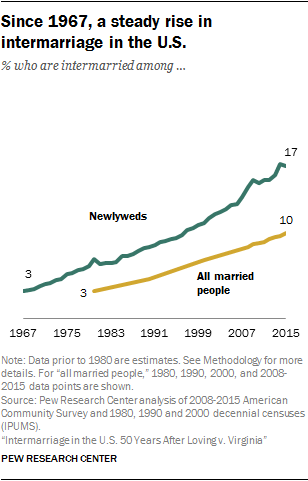 In 1967, the U.S. Supreme Court ruled in the Loving v. Virginia case that marriage across racial lines was legal throughout the country. Intermarriage has increased steadily since then: 1-in-vi U.S. newlyweds (17%) were married to a person of a different race or ethnicity in 2015, a more than fivefold increase from 3% in 1967. Amid all married people in 2015 (not just those who recently wednesday), ten% are now intermarried – 11 million in total.
In 1967, the U.S. Supreme Court ruled in the Loving v. Virginia case that marriage across racial lines was legal throughout the country. Intermarriage has increased steadily since then: 1-in-vi U.S. newlyweds (17%) were married to a person of a different race or ethnicity in 2015, a more than fivefold increase from 3% in 1967. Amid all married people in 2015 (not just those who recently wednesday), ten% are now intermarried – 11 million in total.
Hither are more key findings from Pew Research Heart about interracial and interethnic spousal relationship and families on the 50th ceremony of the landmark Supreme Courtroom decision.
1 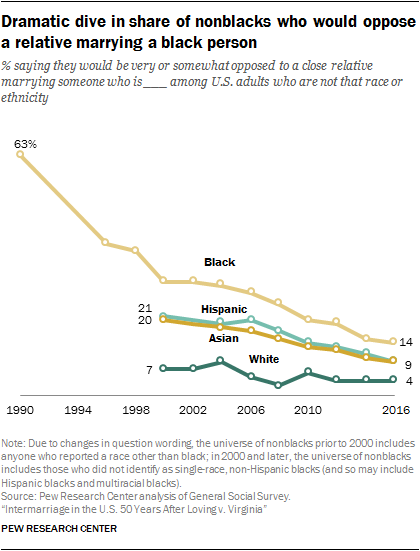 A growing share of adults say interracial marriage is more often than not a adept thing for American society. Almost four-in-ten adults (39%) say the growing number of people marrying someone of a different race is skilful for society, upwardly from 24% in 2010. Adults younger than 30, those with at least a available's caste and those who place every bit a Democrat or lean Democratic are specially likely to say this.
A growing share of adults say interracial marriage is more often than not a adept thing for American society. Almost four-in-ten adults (39%) say the growing number of people marrying someone of a different race is skilful for society, upwardly from 24% in 2010. Adults younger than 30, those with at least a available's caste and those who place every bit a Democrat or lean Democratic are specially likely to say this.
Americans today also are less likely to oppose a close relative marrying someone of a different race or ethnicity. At present, 10% say they would oppose such a spousal relationship in their family, down from 31% in 2000. The biggest turn down has occurred among nonblacks: Today, xiv% of nonblacks say they would oppose a close relative marrying a black person, down from 63% in 1990.
2 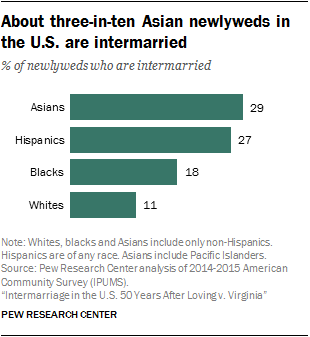 Asian and Hispanic newlyweds are the about probable to be intermarried.Almost three-in-x Asian newlyweds (29%) were married to someone of a different race or ethnicity in 2015, as were 27% of Hispanic newlyweds. Intermarriage for these groups was peculiarly prevalent amongst the U.S. born: 39% of U.South.-born Hispanics and almost half (46%) of U.Southward.-born Asian newlyweds were intermarried in 2015.
Asian and Hispanic newlyweds are the about probable to be intermarried.Almost three-in-x Asian newlyweds (29%) were married to someone of a different race or ethnicity in 2015, as were 27% of Hispanic newlyweds. Intermarriage for these groups was peculiarly prevalent amongst the U.S. born: 39% of U.South.-born Hispanics and almost half (46%) of U.Southward.-born Asian newlyweds were intermarried in 2015.
Although Asian and Hispanic newlyweds are most likely to be intermarried, overall increases in intermarriage have been driven in office by rise intermarriage rates amongst blackness and white newlyweds. The most dramatic increase has occurred among black newlyweds, whose intermarriage rate more than than tripled from 5% in 1980 to xviii% in 2015. Among whites, the rate rose from 4% in 1980 to xi% in 2015.
3  The most common racial or ethnic pairing among newlywed intermarried couples is i Hispanic and one white spouse (42%). The side by side virtually mutual intermarriage pairings are one white and ane Asian spouse (15%). Some 12% of newlywed intermarried couples include 1 white and one multiracial spouse, and xi% include ane white and i blackness spouse.
The most common racial or ethnic pairing among newlywed intermarried couples is i Hispanic and one white spouse (42%). The side by side virtually mutual intermarriage pairings are one white and ane Asian spouse (15%). Some 12% of newlywed intermarried couples include 1 white and one multiracial spouse, and xi% include ane white and i blackness spouse.
ivNewlywed black men are twice as likely as newlywed blackness women to be intermarried. In 2015, 24% of recently married blackness men were intermarried, compared with 12% of newly married black women. There are likewise notable gender differences among Asian newlyweds: Just over one-third (36%) of newlywed Asian women were intermarried in 2015, compared with 21% of recently married Asian men.
Among white and Hispanic newlyweds, intermarriage rates are similar for men and women.
5Since 1980, an educational gap in intermarriage has begun to sally. While the rate of intermarriage did not differ significantly by educational attainment in 1980, today there is a pocket-sized gap. In 2015, xiv% of newlyweds with a high school diploma or less were married to someone of a unlike race or ethnicity. In contrast, 18% of those with some college experience and 19% of those with a bachelor's degree or more were intermarried.
The educational gap is nigh hit among Hispanics. Nearly half (46%) of Hispanic newlyweds with a bachelor's degree were married to someone of a different race or ethnicity in 2015, yet this share drops to xvi% for those with a high school diploma or less.
6One-in-seven U.South. infants (14%) are multiracial or multiethnic. 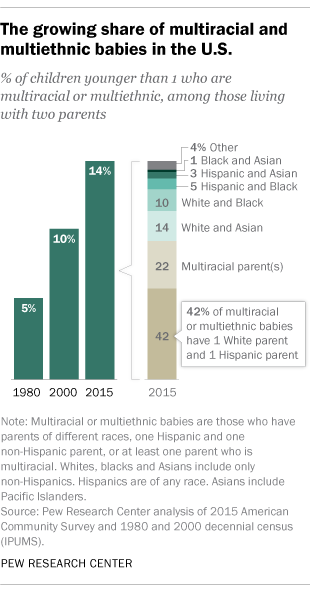 This share is most triple the share (v%) in 1980. Multiracial or multiethnic infants include children younger than 1 year oldwho alive with two parents andwhose parents are each of a dissimilar race, those with ane Hispanic and i non-Hispanic parent, and those with at to the lowest degree one parent who identifies as multiracial.
This share is most triple the share (v%) in 1980. Multiracial or multiethnic infants include children younger than 1 year oldwho alive with two parents andwhose parents are each of a dissimilar race, those with ane Hispanic and i non-Hispanic parent, and those with at to the lowest degree one parent who identifies as multiracial.
Among interracial and interethnic infants, the nearly common racial/ethnic combination for parents is one non-Hispanic white and 1 Hispanic parent (42%). The next largest share of these infants have at least ane parent who identifies every bit multiracial (22%), while 14% take one white and 1 Asian parent and x% have 1 white and one black parent. The share of infants with interracial or interethnic parents also varies considerably across states, from 44% amidst those in Hawaii to iv% among those in Vermont.
sevenHonolulu has the highest share of intermarried newlyweds of any major metropolitan area in the U.S. Four-in-10 newlyweds in Honolulu (42%) are married to someone of a dissimilar race or ethnicity, followed by newlyweds living in the Las Vegas (31%) and Santa Barbara, California (30%) metro areas. At the aforementioned time, just 3% of newlyweds in or effectually Asheville, North Carolina, and Jackson, Mississippi, are intermarried.
(Interactive : Which U.S. metro areas accept the largest and smallest shares of intermarried newlyweds?)
Generally, newlyweds living in metropolitan areas are more likely to be intermarried (18%) than those in more rural, non-metro areas (11%).
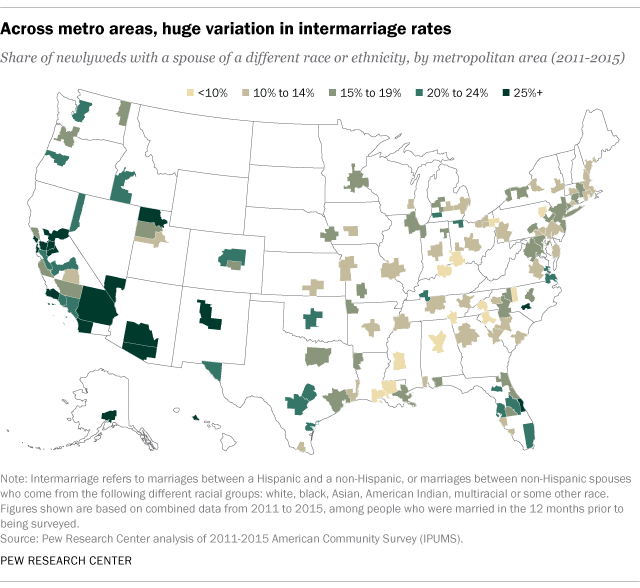
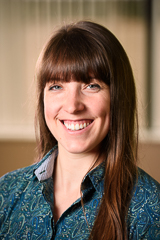
Kristen Bialik is a former research assistant at Pew Enquiry Center.
Source: https://www.pewresearch.org/fact-tank/2017/06/12/key-facts-about-race-and-marriage-50-years-after-loving-v-virginia/
0 Response to "About 7 in 10 African American Babies and Half of Hispanic Babies Are Born ____."
ارسال یک نظر